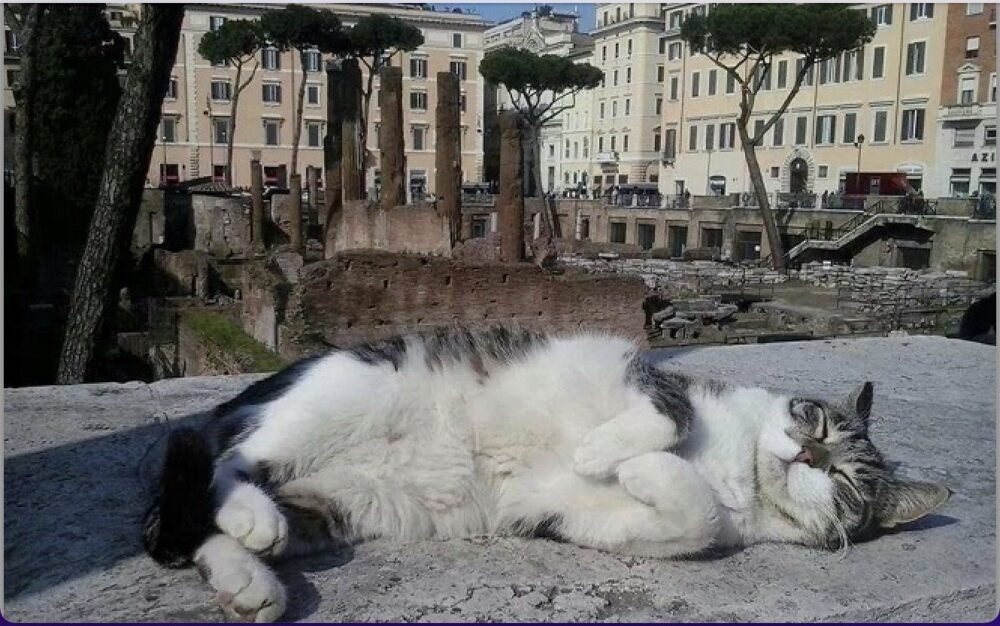On February 17, Rome celebrated the “National cat day” With events and initiatives dedicated to felines that populate the city. Between cultural events, adoption campaigns and guided tours of historic feline colonies, the capital has paid homage to its cats, symbols of independence and silent custodians of its millennial history
The “National cat day”: origin and meaning
The “National cat day” It was established in 1990 thanks to the initiative of the journalist Claudia Angeletti, who proposed a survey to the readers of the Tuttogatto magazine to choose a date dedicated to these fascinating animals. The choice fell on February 17 for a series of symbolic motivations.
February, according to astrological tradition, is the month of aquarium, zodiac sign associated with freedom, anticonformism and independence, characteristics that perfectly reflect the nature of the cats. The number 17, often linked to bad luck in popular culture, has instead been reinterpreted in a positive key: the cat has always been an animal that challenges fate and overcomes any adversity with agility and cunning.
In addition to being an opportunity to celebrate the beauty and elegance of these animals, the day has a deeper goal: to raise public awareness of the protection of cats, in particular stray or abandoned ones. Every year, throughout Italy, Animalist associationsshelters and volunteers organize events to promote the well -being of felines, encourage adoptions and contrast the phenomenon of stray.
A Romathis celebration assumes an even more special meaning, since the city has always has a privileged relationship with cats, which inhabit its ruins, its alleys and gardens, becoming an integral part of its urban landscape.
Rome and the cat day: a tribute to the felines of the capital
One of the symbolic places of the day was the archaeological site of Largo di Torre Argentina, where one of the most famous feline colonies in the capital lives. Here, volunteers and associations welcomed visitors with guided colony visits, telling the history of cats who live in the site and explaining the importance of the care and protection activities carried out daily. The event also represented an opportunity to encourage responsible adoptions, presenting some of the felines in search of a house to citizens.
Parallel, the Bioparco of Rome organized educational meetings to raise awareness and children on the cat’s ethology, exploring his role in history, myth and nature. Through interactive workshops and educational activities, the participants were able to deepen their knowledge of these fascinating animals and better understand their needs.
From Rione Monti to the Acatholic cemetery of Testaccio
In the heart of Trastevere and in the Monti district, bookstores, literary cafes and cultural spaces they hosted readings and meetings on the representation of the cat in literature, art and cinema. Through photographic exhibitions and projections, it was possible to discover how the felines have been the protagonists of stories and legends over the centuries, from ancient Rome to the present day.
Even the Acatholic cemetery of Testaccio, known for its historic feline colony, has joined the celebration with a day of open doors, allowing visitors to get to know the work done by the volunteers for the care of the cats who live among the tombs of poets and artists.
Finally, numerous shops and clubs in the city participated with solidarity initiatives, allocating parts of the collections to fundraising for the support of feline colonies and shelters. But why does the eternal city have such a special relationship with cats?
A feline past: cats in ancient Rome
The presence of cats in Rome has its roots in ancient times. Already during the Republican age, these animals were considered precious allies in the protection of food stocks, since rodents and other parasites hunted. Our ancestors appreciated their skills so much that they were often depicted on mosaics and bas -reliefs as symbols of cunning and vigilance.
From Egypt to Rome: the journey of cats between myths and reality
The felines were not originally from Europe, but the Roman merchants and legionaries introduced them into Rome by transporting them along the commercial routes from the Near East and Egypt, where they were venerated as an incarnation of the goddess Bastet, protector of the house and fertility, where They were venerated as an incarnation of the goddess Bastet, protector of the house and fertility.
The Romans, fascinated by these animals, welcomed them in their homes and made them part of their daily life. The matrons kept them in their luxurious domus, while the imperial sailors considered them a lucky charm and raised them on ships to protect the loads from the infestations of mice.
From the Empire to the Middle Ages: the survival between superstition and devotion
With the fall of the Roman Empire and the arrival of the Middle Ages, the relationship between man and cat suffered evolution. While in many parts of Europe these animals began to be persecuted for superstitious beliefs, in Rome they preserved their privileged status. The ancient ruins became the perfect refuge for feline colonies, allowing them to survive even in the darkest periods in history.
But let’s go back to the celebration.
A day for the protection of ours “A-Mici”
The national day of the cat is not only an opportunity to enhance the beauty and charm of these animals, but also represents a moment of reflection on their protection and role in our cities. In Rome, cats are not simple discrete appearances: they are an integral part of the urban fabric, silent custodians of a glorious past and symbols of a freedom that has always distinguished them.
From the temples of antiquity to the sworn alleys of life, the cats continue to populate the capital, giving them an aura of timeless mystery and beauty.
Because, after all, in Rome, the real emperors are not men, but cats.

